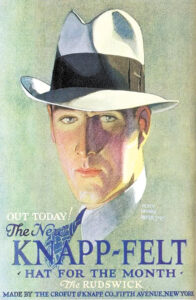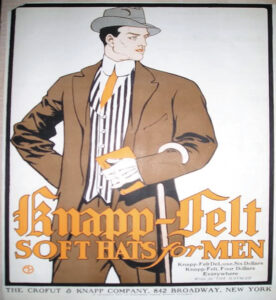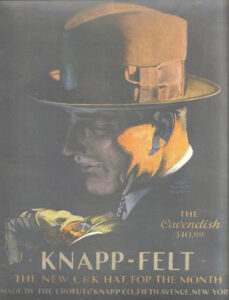 Excerpt from the Hatted Professor J. Bradford Bowers
Excerpt from the Hatted Professor J. Bradford Bowers So how does a company go from one man working out of a cow shed to the second largest hat company in America? (They did eventually become the largest, but that wasn’t until after 1970 and the closure of the Stetson factory in Philadelphia.)
The short, and perhaps overly obvious, answer is through a lot of hard work and dedication. Success becomes much more likely to happen when you throw innovation into the mix, and this is the case with Crofut & Knapp. Add in the talent of promoting your employees into positions where they can do the most for the company, and you have a recipe for success. Two key components went hand in hand with their success. First, they offered a high-quality product at premium prices. While the premium price created a hurdle to overcome with consumers, the second component dealt very well with that hurdle: marketing and advertising. In this, Crofut & Knapp were innovators, setting a standard of excellence that left the other hat companies playing catch-up.
The hatting industry underwent a monumental change in the first half of the nineteenth century due to the transportation revolution and the industrial revolution, just as most American industries did. The hat factory evolved from a small, locally-owned shop into a much larger facility employing ever greater numbers of people.
Prior to the industrial revolution, hat manufacturers worked out of small shops and sold their hats locally. The shop was run by a single craftsman, or master, who might employ up to perhaps as many as four apprentices. Each craftsman performed all of the required steps to make a hat from a handful of fur to a finished, wearable product. Each small shop served a town, or perhaps a county, but their market did not reach much beyond that.
 With the advent of the industrial and transportation revolutions, machinery aided in the manufacturing process and the concept of division of labor meant that workers began specializing in different parts of the production process. Some factories only performed one part of the process, such as the forming of felt bodies, and left the finishing to other companies. Distribution of the hats was left up to jobbers in the cities. Some companies did keep everything in house. In any case, hat production was increased, hat prices became more affordable, and more people could afford to buy better quality hats.
With the advent of the industrial and transportation revolutions, machinery aided in the manufacturing process and the concept of division of labor meant that workers began specializing in different parts of the production process. Some factories only performed one part of the process, such as the forming of felt bodies, and left the finishing to other companies. Distribution of the hats was left up to jobbers in the cities. Some companies did keep everything in house. In any case, hat production was increased, hat prices became more affordable, and more people could afford to buy better quality hats. Concentration in the hat industry meant that regional centers of hatting grew in importance, such as Orange, New Jersey, and Danbury, Connecticut, both of which saw larger factories employing fifty or more workers as early as 1810. By 1860, the modern hat industry was in full swing, with many steps in production utilizing machinery, but a large part of the work still involved skilled handiwork. Curled brims, for instance, became popular on high silk hats in the 1840s, and these same curls, such as the D’Orsay, would be translated over to stiff hats (Derbies). The brim curler was a skilled tradesman who performed his work by hand with hot irons, not mechanization.
Into this new era of mechanization came James H. Knapp, who started out exactly as hatters had for centuries, as a one-man operation. With the partnership of Andrew J. Crofut, they launched the Derby as their chief product, and began the long road to success. Much of the first fifty years of Crofut & Knapp is shrouded in the mists of time. Advertising was typically done in local papers by the retailers, usually consisting of text and very few, if any, images of the product. The text would extol the virtues of the product, addressing the needs of the individvidual being targeted in the ad.
 It was not until well into the twentieth century that companies would change the nature of advertising, focusing not on customers’ needs, as had previously been the case, but on their wants and desires instead. Advertising would move away from the traditional textual analysis of the properties of the product into a much more ambiguous and visual form, designed to entice consumers to purchase the product merely because they desired it. Croft & Knapp led the way among hat manufacturers in this advertising makeover and perhaps among most industries as a whole.
It was not until well into the twentieth century that companies would change the nature of advertising, focusing not on customers’ needs, as had previously been the case, but on their wants and desires instead. Advertising would move away from the traditional textual analysis of the properties of the product into a much more ambiguous and visual form, designed to entice consumers to purchase the product merely because they desired it. Croft & Knapp led the way among hat manufacturers in this advertising makeover and perhaps among most industries as a whole. The first decade of the twentieth century was a pivotal year for the company, a year that would see several different innovations in marketing that would propel the company into a position of prominence.















Follow Us